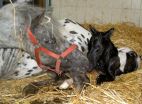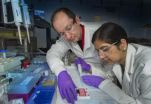(Press-News.org) Foaling in horses is extremely fast. Labour and the active part of foaling, resulting in delivery of the foal, take 10 to 20 minutes and are considerably shorter than giving birth in humans or in cows. Is this brief period stressful for the animals or are horses more relaxed than humans when giving birth? This issue has been addressed by Christina Nagel and colleagues, who closely observed 17 foalings at the Brandenburg State Stud in Neustadt (Dosse), Germany, as well as recording electrocardiograms before, during and after foaling. The researchers also took samples of saliva and blood and analysed the levels of stress hormones such as cortisol and epinephrine. As Nagel summarizes, "Normal foaling appears to cause just the opposite of a stress response".
Cardiac and circulatory demands remain at a low level
Surprisingly, during labour the heart rate of mares does not increase. On the contrary, the mares even miss some individual heart beats due to delayed stimulus conduction in the heart. In humans, such second-degree atriventricular (AV) blocks often require medical treatment but many healthy horses show AV blocks at rest. On physical activity, e.g. when the horse is ridden, the heart beat becomes regular and the beat frequency increases. The finding of AV blocks during foal¬ing suggests that mares are strongly influenced by the parasympathetic nervous system, which usually causes a state of rest and relaxation. Its antagonist, the sympathetic nervous system, would prepare the organism for a stress response but does not seem to be active while the animals are giving birth.
No stress during foaling
The level of stress hormones remains low in foaling mares and the researchers did not find an adrenaline rush at any point. Foaling clearly does not evoke a stress response. The need to care for the newly born foal was also not perceived as stressful: contact between the mare and the foal was associated with a further state of relief and relaxation.
Horses thus experience giving birth very differently from human mothers. They need a safe environment to give birth: all the foals in the study were born at night, when the stable was quiet. As the Head of the Research Group, Christine Aurich, explains, "Parturition in horses requires a state of relaxation in the mare. This is an advantage in wild horses because mares can postpone labour until they perceive the environment as calm and safe. Once this is the case, foaling proceeds within a very short time."
INFORMATION:
The article "Parturition in horses is dominated by parasympathetic activity of the autonomous nervous system", by Christina Nagel, Regina Erber, Natascha Ille, Mareike von Lewinski, Jörg Aurich, Erich Möstl and Christine Aurich has just been published in the scientific journal Theriogenology. http://dx.doi.org/10.1016/j.theriogenology.2014.03.015
The study was conducted at the Graf Lehndorff Institute for Equine Science, a joint research unit of the Vetmeduni Vienna and the Brandenburg State Stud at Neustadt (Dosse), Germany.
About the University of Veterinary Medicine, Vienna
The University of Veterinary Medicine, Vienna in Austria is one of the leading academic and research institutions in the field of Veterinary Sciences in Europe. About 1,200 employees and 2,300 students work on the campus in the north of Vienna which also houses five university clinics and various research sites. Outside of Vienna the university operates Teaching and Research Farms. http://www.vetmeduni.ac.at
Scientific Contact:
Dr. Christina Nagel
Clinical Unit of Obstetrics, Gynaecology and Andrology
University of Veterinary Medicine Vienna (Vetmeduni Vienna)
T +43 1 250776408
christina.nagel@vetmeduni.ac.at
Released by:
Dr. Susanna Kautschitsch
Science Communication / Public Relations
University of Veterinary Medicine Vienna (Vetmeduni Vienna)
T +43 1 25077-1153
susanna.kautschitsch@vetmeduni.ac.at
Foaling mares are totally relaxed -- no stress
2014-06-11
ELSE PRESS RELEASES FROM THIS DATE:
Making new species without sex
2014-06-11
This news release is available in German. Occasionally, two different plant species interbreed with each other in nature. This usually causes problems since the genetic information of both parents does not match. But sometimes nature uses a trick. Instead of passing on only half of each parent's genetic material, both plants transmit the complete information to the next generation. This means that the chromosome sets are totted up. The chromosomes are then able to find their suitable partner during meiosis, a type of cell division that produces an organism's reproductive ...
Having authoritarian parents increases the risk of drug use in adolescents
2014-06-11
Alcohol, tobacco and cannabis use is very widespread among youths in Spain compared to the majority of European countries, according to the latest data from the European Monitoring Centre for Drugs and Drug Addiction.
An international team, led by the European Institute of Studies on Prevention (IREFREA) with headquarters in Mallorca, together with other European and Spanish universities (Oviedo, Santiago de Compostela and Valencia), has analysed the role that parents play at the time of determining the risk of their children using alcohol, tobacco and cannabis in six ...
Herpes infected humans before they were human
2014-06-11
Researchers at the University of California, San Diego School of Medicine have identified the evolutionary origins of human herpes simplex virus (HSV) -1 and -2, reporting that the former infected hominids before their evolutionary split from chimpanzees 6 million years ago while the latter jumped from ancient chimpanzees to ancestors of modern humans – Homo erectus – approximately 1.6 million years ago.
The findings are published in the June 10 online issue of Molecular Biology and Evolution.
"The results help us to better understand how these viruses evolved and found ...
Canadian physicians lack knowledge and confidence about breastfeeding
2014-06-11
OTTAWA, Ontario – June 11, 2014 –The results of a national research project to assess breastfeeding knowledge, confidence, beliefs, and attitudes of Canadian physicians are available today in the Journal of Human Lactation.
"Physicians' attitudes and recommendations are known to directly impact the duration that a mom breastfeeds," said Dr. Catherine Pound, pediatrician and lead author of the study at the Children's Hospital of Eastern Ontario (CHEO). "Worldwide healthcare organizations readily promote the benefits of breastfeeding, and yet now we find a gap exists where ...
Researchers identify regulation process of protein linked to bipolar disorder
2014-06-11
BOSTON (June 11, 2014) — Researchers from Tufts have gained new insight into a protein associated with bipolar disorder. The study, published in the June 3 issue of Science Signaling, reveals that calcium channels in resting neurons activate the breakdown of Sp4, which belongs to a class of proteins called transcription factors that regulate gene expression.
This study, led by Grace Gill, identifies a molecular mechanism regulating Sp4 activity. Her previous research had determined that reduced levels of Sp4 in the brain are associated with bipolar disorder. Her work ...
DNA-linked nanoparticles form switchable 'thin films' on a liquid surface
2014-06-11
UPTON, NY—Scientists seeking ways to engineer the assembly of tiny particles measuring just billionths of a meter have achieved a new first—the formation of a single layer of nanoparticles on a liquid surface where the properties of the layer can be easily switched. Understanding the assembly of such nanostructured thin films could lead to the design of new kinds of filters or membranes with a variable mechanical response for a wide range of applications. In addition, because the scientists used tiny synthetic strands of DNA to hold the nanoparticles together, the study ...
Scientists unravel the genetic secrets of nature's master of mimicry
2014-06-11
Scientists investigating how one of the greatest shape shifters in the natural world is able to trick predators to avoid being eaten have identified the gene behind the fascinating feat.
The African Swallowtail butterfly, also known as the 'Mocker Swallowtail' or the 'Flying Handkerchief,' can appear to change both colour and shape.
Males of the species fly boldly around the tree tops, their rapid flight making them look like shaking handkerchiefs, however females lurk in the bushes and pretend to be examples of Monarch butterflies that are nasty to eat.
The females ...
Infant nutrition and development of type 1 diabetes
2014-06-11
Previous studies have indicated that early exposure to complex foreign proteins, such as cow's milk proteins, increases the risk of type 1 diabetes in predisposed individuals.
"Therefore, In 2002, we embarked on a large-scale study on more than 2100 infants with a family member affected by type 1 diabetes and with genetic disease susceptibility to find an answer to the question whether delaying the exposure to complex foreign proteins will decrease the risk of diabetes", tells Professor Mikael Knip from the University of Helsinki, the leader of the TRIGR Study.
After ...
New guidance on how and when to stop immunosuppressants in lupus patients
2014-06-11
A new study presented today at the European League Against Rheumatism Annual Congress (EULAR 2014) showed that, for the majority of lupus patients who are in remission, it is possible to successfully stop immunosuppressant therapy without triggering a flare of their disease.1 Within two years, it was possible to stop the immunosuppressant in about 70% of clinically stable patients. Half were successful within three years, and this proportion remained stable for up to five years.1
Lupus is a chronic inflammatory disease that can affect any organ system, but mainly involves ...
First biomarkers found to predict severe osteoarthritis
2014-06-11
The results of a study presented today at the European League Against Rheumatism Annual Congress (EULAR 2014) identify a correlation between the presence of biomarkers in the blood, known as micro RNAs (miRNAs), and the development of severe osteoarthritis (OA) of the knee or hip joint. The findings suggest that miRNAs may be used as biomarkers to predict severe OA disease in individuals.2
Preventative measures and early treatments are considered to be the most effective way of managing OA, but to date there has been no way of identifying the disease early on.2
"These ...



